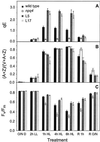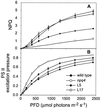PsbS-dependent enhancement of feedback de-excitation protects photosystem II from photoinhibition
- PMID: 12417767
- PMCID: PMC137571
- DOI: 10.1073/pnas.232447699
PsbS-dependent enhancement of feedback de-excitation protects photosystem II from photoinhibition
Abstract
Feedback de-excitation (qE) regulates light harvesting in plants to prevent inhibition of photosynthesis when light absorption exceeds photosynthetic capacity. Although the mechanism of qE is not completely understood, it is known to require a low thylakoid lumen pH, de-epoxidized xanthophylls, and the photosystem II protein PsbS. During a short-term 4-h exposure to excess light, three PsbS- and qE-deficient Arabidopsis thaliana mutants that differed in xanthophyll composition were more photoinhibited than the wild type. The extent of photoinhibition was the same in all of the mutants, suggesting that qE capacity rather than xanthophyll composition is critical for photoprotection in short-term high light, in contrast to longer-term high light conditions (days) when additional antioxidant roles of specific xanthophylls are evident. Plants with a 2-fold increase in qE capacity were generated by overexpression of PsbS, demonstrating that the level of PsbS limits the qE capacity in wild-type Arabidopsis. These results are consistent with the idea that variations in PsbS expression are responsible for species-specific and environmentally induced differences in qE capacity observed in nature. Furthermore, plants with higher qE capacity were more resistant to photoinhibition than the wild type. Increased qE was associated with decreased photosystem II excitation pressure and changes in the fractional areas of chlorophyll a fluorescence lifetime distributions, but not the lifetime centers, suggesting that qE protects from photoinhibition by preventing overreduction of photosystem II electron acceptors. Engineering of qE capacity by PsbS overexpression could potentially yield crop plants that are more resistant to environmental stress.
Figures






Similar articles
-
Molecular and global time-resolved analysis of a psbS gene dosage effect on pH- and xanthophyll cycle-dependent nonphotochemical quenching in photosystem II.J Biol Chem. 2002 Sep 13;277(37):33590-7. doi: 10.1074/jbc.M204797200. Epub 2002 Jul 10. J Biol Chem. 2002. PMID: 12110676
-
Characterization of a nonphotochemical quenching-deficient Arabidopsis mutant possessing an intact PsbS protein, xanthophyll cycle and lumen acidification.Planta. 2006 Feb;223(3):532-41. doi: 10.1007/s00425-005-0093-z. Epub 2005 Sep 1. Planta. 2006. PMID: 16136330
-
Regulation of photosynthetic light harvesting involves intrathylakoid lumen pH sensing by the PsbS protein.J Biol Chem. 2004 May 28;279(22):22866-74. doi: 10.1074/jbc.M402461200. Epub 2004 Mar 21. J Biol Chem. 2004. PMID: 15033974
-
Is PsbS the site of non-photochemical quenching in photosynthesis?J Exp Bot. 2005 Jan;56(411):375-82. doi: 10.1093/jxb/eri056. Epub 2004 Dec 20. J Exp Bot. 2005. PMID: 15611143 Review.
-
The evolution of the photoprotective antenna proteins in oxygenic photosynthetic eukaryotes.Biochem Soc Trans. 2018 Oct 19;46(5):1263-1277. doi: 10.1042/BST20170304. Epub 2018 Aug 28. Biochem Soc Trans. 2018. PMID: 30154089 Review.
Cited by
-
A kinetic model of rapidly reversible nonphotochemical quenching.Proc Natl Acad Sci U S A. 2012 Sep 25;109(39):15757-62. doi: 10.1073/pnas.1211017109. Epub 2012 Aug 13. Proc Natl Acad Sci U S A. 2012. PMID: 22891305 Free PMC article.
-
Evidence for leaf fold to remedy the deficiency of physiological photoprotection for photosystem II.Photosynth Res. 2012 Feb;110(3):185-91. doi: 10.1007/s11120-011-9717-2. Epub 2011 Dec 25. Photosynth Res. 2012. PMID: 22198728
-
Barley's Second Spring as A Model Organism for Chloroplast Research.Plants (Basel). 2020 Jun 27;9(7):803. doi: 10.3390/plants9070803. Plants (Basel). 2020. PMID: 32604986 Free PMC article. Review.
-
Kinetic and spectral resolution of multiple nonphotochemical quenching components in Arabidopsis leaves.Plant Physiol. 2010 Mar;152(3):1611-24. doi: 10.1104/pp.109.148213. Epub 2009 Dec 23. Plant Physiol. 2010. PMID: 20032080 Free PMC article.
-
Origin of absorption changes associated with photoprotective energy dissipation in the absence of zeaxanthin.J Biol Chem. 2011 Jan 7;286(1):91-8. doi: 10.1074/jbc.M110.184887. Epub 2010 Oct 29. J Biol Chem. 2011. PMID: 21036900 Free PMC article.
References
-
- Niyogi K. K. (1999) Annu. Rev. Plant Physiol. Plant Mol. Biol. 50, 333-359. - PubMed
-
- Horton P., Ruban, A. V. & Walters, R. G. (1996) Annu. Rev. Plant Physiol. Plant Mol. Biol. 47, 655-684. - PubMed
-
- Yamamoto H. Y., Nakayama, T. O. M. & Chichester, C. O. (1962) Arch. Biochem. Biophys. 97, 168-173. - PubMed
-
- Demmig-Adams B. (1990) Biochim. Biophys. Acta 1020, 1-24.
Publication types
MeSH terms
Substances
LinkOut - more resources
Full Text Sources
Other Literature Sources
Molecular Biology Databases

